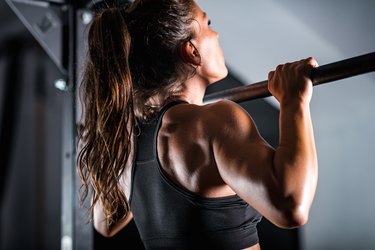
Pull-up or chin-up bars are an inexpensive piece of home workout equipment. When you're installing one, you need to take two factors into account if you want to install it at the correct height.
The bar needs to be low enough that you don't bump your head at the top of your repetitions. It also needs to be low enough so you can do full pull-ups or chin-ups without your legs interfering with range of motion.
Video of the Day
Video of the Day
First, a Refresher on Pull-Up Basics
Oregon-based fitness coach Ben Cohn says that to perform a pull-up correctly, you begin by hanging from the bar with arms straight but not locked.
For an overhand pull-up, you grip the bar with your fingers facing away from your face. Bend your arms to pull your body up until your chin is above the bar, or until you gently touch your shoulders to the bar.
For an underhand pull-up, grip the bar with your fingers facing your face, then bend your arms until your chin is above the bar.
So, What Is the Ideal Height for a Pull-Up Bar?
How far off the ground your bar needs to be is a factor of how tall you and the other users are. Cohn, who has set up exercise gear for several programs and clients, recommends mounting a pull-up bar at eye level for the tallest person likely to use the bar. Shorter folks using the bar may need a box or stool to reach the bar, or they can jump up to reach it.
Your head is about 1 foot high. Given room for additional motion, this means you should mount your pull-up bar a minimum of 18 inches below the ceiling where your head will be while performing pull-ups. Cohn notes that if you exclusively do shoulder-to-bar pull-ups, this is not as important.
That being said, not everyone has enough room in their home to mount a pull-up bar at that height. So, if you need to mount your pull-up bar lower — maybe you have a low ceiling, for instance — Cohn says you may need to bend your legs during some or all of the motion of a pull-up. Similarly, if you're too tall for the bar, the same solution — bending your legs — applies.
Specs of a Standard Pull-Up Bar
What Are the Best Places to Mount a Pull-Up Bar at Home?
There are three types of pull-up bars, according to Men's Journal, and you can put each in a different place in your home.
- Doorway: Is the length of a standard door frame, so you can mount it in your doorway.
- Wall-Mounted: You bolt this onto your wall.
- Freestanding: Has a stable base and a bar attached to the top.
Here are the pros and cons of each:
Doorway
Pros
- One of the most common places to mount a pull-up bar at home, because doorways are found in every home.
- You can position the bar so it's outside the door frame so you'll have headroom all the way to the ceiling, not just the door jamb, according to Cohn.
- The least expensive option.
Cons
- Pull-up bars in high-traffic doorways cause accidentally bumped heads.
- Can damage your doorframe, depending on the quality of the pull-up bar you buy.
Wall-Mounted
Pros
- Very sturdy.
Cons
- More expensive than a doorway pull-up bar.
- You need dedicated wall space for it (and a strong wall).
- You need power tools to set it up.
Freestanding
Pros
- Can double as a squat rack.
- The most sturdy option.
- Can use it outdoors if you wish.
- Best for a dedicated home gym.
Cons
- Generally the most expensive option.
- Takes up the most space, not ideal for small apartments.
How Do You Know What Type of Pull-Up Bar Is Right for You?
To recap, if you have the least amount of room in your house and only have doorways, the doorway pull-up bar is your best bet. These are also the least expensive option.
If you have a little more wall space, you can opt for a wall-mounted pull-up bar. While these are slightly more expensive, they are a sturdier option because they're bolted into a wall. Keep in mind, you'll need tools — like a drill and a level — and a bit of DIY knowledge to install this type of pull-up bar.
If you have a lot of space — either outside, in a garage or have a large home gym room — a freestanding pull-up bar might be the one for you. While these are the most expensive option and aren't ideal for small apartments, these are the most sturdy option, and they can also double as a squat rack, so you can get the most bang for your buck.
Related Reading